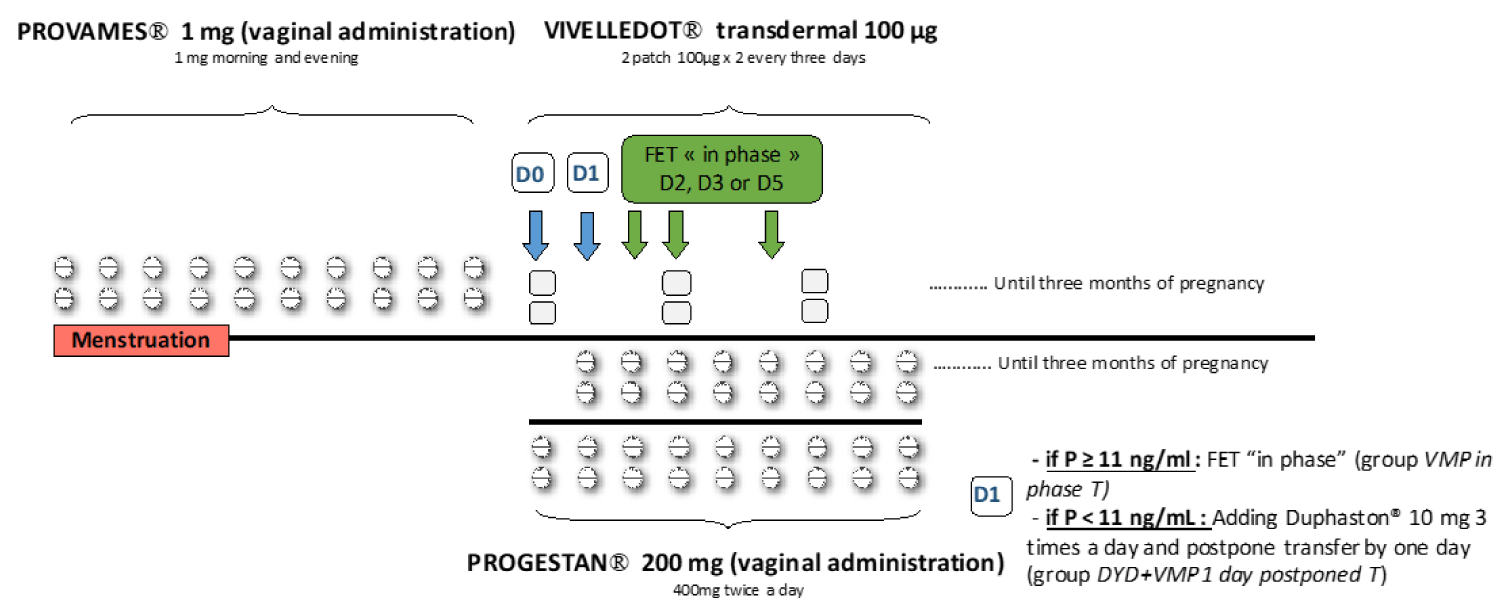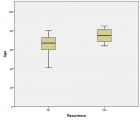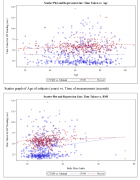Figure 1
Addition of dydrogesterone to vaginal progesterone and transfer postponement improve outcomes in patients with low progesterone levels in hormonally substituted cycles for frozen-thawed embryo transfer
Anne Lecourt, Julie Labrosse, Maeliss Peigné, Claire Vinolas, Laetitia Laup, Christophe Sifer, Michael Grynberg and Isabelle Cedrin-Durnerin*
Published: 11 March, 2022 | Volume 5 - Issue 1 | Pages: 027-035

Figure 1:
Endometrial preparation. Provames® is started on the first day of a natural menstrual cycle, after 10 days of treatment, a monitoring by blood sample to measure estradiol (E2), progesterone (P) and LH levels and by vaginal ultrasound is performed. If endometrial thickness was ≥ 7 mm with a triple-line pattern and serum P levels were lower than 1.5 ng/mL, Progestan® was initiated in the evening (day-0 of P administration D0) and estrogen administration was switched from the vaginal to the transdermal route (Vivelledot®). Serum P was measured in the morning on the day following exogenous P introduction after the second vaginal administration (day-1 of P administration, D1). When P levels were ≥11 ng/mL, FET was performed on day 2 (D2) of progesterone administration for day-2 embryos, on day 3 (D3) for day-3 embryos and on day 5 (D5) for blastocysts (group VMP in phase T. When P levels were < 11 ng/mL, Duphaston® was added to vaginal P and FET was postponed by one day (group DYD+VMP 1 day postponed T).
Read Full Article HTML DOI: 10.29328/journal.cjog.1001103 Cite this Article Read Full Article PDF
More Images
Similar Articles
-
The validity of progesterone level on hCG injection day in the prediction of IVF/ICSI cycles’ outcomeMostafa A Abolfotouh*,Hallah Al-Anazi,Samar Hassan. The validity of progesterone level on hCG injection day in the prediction of IVF/ICSI cycles’ outcome. . 2019 doi: 10.29328/journal.cjog.1001028; 2: 095-100
-
Addition of dydrogesterone to vaginal progesterone and transfer postponement improve outcomes in patients with low progesterone levels in hormonally substituted cycles for frozen-thawed embryo transferAnne Lecourt,Julie Labrosse,Maeliss Peigné,Claire Vinolas,Laetitia Laup,Christophe Sifer,Michael Grynberg,Isabelle Cedrin-Durnerin*. Addition of dydrogesterone to vaginal progesterone and transfer postponement improve outcomes in patients with low progesterone levels in hormonally substituted cycles for frozen-thawed embryo transfer. . 2022 doi: 10.29328/journal.cjog.1001103; 5: 027-035
-
Neonatal Mortality Rate among Twin and Singleton Births with the Gestational Age of 34-37 Weeks: A Population-Based StudySedigheh Hantoushzadeh, Kayvan Mirnia, Hananeh Sadat Sadeghi, Parvaneh Sadeghimoghadam*, Mohammad Aghaali, Mohammad Heidarzadeh, Abbas Habibelahi, Shima Rafiee, Mohammad Haddadi, Amir Naddaf. Neonatal Mortality Rate among Twin and Singleton Births with the Gestational Age of 34-37 Weeks: A Population-Based Study. . 2023 doi: 10.29328/journal.cjog.1001134; 6: 088-094
-
Near-miss Women Causes and Prevalence in Alobied Maternity HospitalAyat Eltigani, Taha Umbeli Ahmed, Awadalla Abdelwahid Suliman*, Abdelsalam SalahEldin, Isra Siralkatim, Hajar Suliman. Near-miss Women Causes and Prevalence in Alobied Maternity Hospital. . 2023 doi: 10.29328/journal.cjog.1001149; 6: 185-192
-
COVID-19 Pneumonia in Pregnancy: A Retrospective Study on Maternal and Neonatal OutcomesBenlghazi Abdelhamid*, Belouad Moad, Hanane Dabdi, Bouhtouri Yassine, Messaoudi Hamza1, Benali Saad, Ait Bouhou Rachid, El Mangoub Fatima, Elhassani Mly El Mehdi, Kouach Jaouad. COVID-19 Pneumonia in Pregnancy: A Retrospective Study on Maternal and Neonatal Outcomes. . 2024 doi: 10.29328/journal.cjog.1001163; 7: 051-055
-
Prospective Community-based Study of Still Births in Remote Villages with Low ResourcesShakuntala Chhabra*, Naman Chhabda, Afreen S, Rathod M. Prospective Community-based Study of Still Births in Remote Villages with Low Resources. . 2024 doi: 10.29328/journal.cjog.1001168; 7: 072-077
-
The Clinical Pregnancy and Live Birth Following Transfer of One Arrested Embryo: A Case ReportAli Asghar Ghafarizade, Elham Shojafar*, Samira Naderi, Fatemeh Seifi, Alireza Noshad, Zohreh Lavasani, Zahra Kalhori, Elahe Ghadiri. The Clinical Pregnancy and Live Birth Following Transfer of One Arrested Embryo: A Case Report. . 2024 doi: 10.29328/journal.cjog.1001175; 7: 112-114
-
Luteal Phase Support in in vitro Fertilization at 2,800 Meters above Sea Level: Micronized Progesterone versus Combination with DydrogesteroneJosé A Duran,Mónica Mullo,Sindy T Fuel,Oscar D Salazar*,Juan P Cabrera. Luteal Phase Support in in vitro Fertilization at 2,800 Meters above Sea Level: Micronized Progesterone versus Combination with Dydrogesterone. . 2025 doi: 10.29328/journal.cjog.1001193; 8: 080-081
Recently Viewed
-
Analysis and Control of a Suicide Dynamics ModelLakshmi N Sridhar*. Analysis and Control of a Suicide Dynamics Model. Arch Psychiatr Ment Health. 2025: doi: 10.29328/journal.apmh.1001059; 9: 022-028
-
Effectiveness of prenatal intensive counselling on knowledge, attitude and acceptance of post placental intrauterine contraceptive device among mothersM Shanthini,Manjubala Dash*,A Felicia Chitra,S Jayanthi,P Sujatha. Effectiveness of prenatal intensive counselling on knowledge, attitude and acceptance of post placental intrauterine contraceptive device among mothers. Clin J Obstet Gynecol. 2020: doi: 10.29328/journal.cjog.1001044; 3: 021-025
-
Timely initiation of breastfeeding and associated factors among mothers who have infants less than six months of age in Gunchire Town, Southern Ethiopia 2019Ephrem Yohannes*,Tsegaye Tesfaye. Timely initiation of breastfeeding and associated factors among mothers who have infants less than six months of age in Gunchire Town, Southern Ethiopia 2019. Clin J Obstet Gynecol. 2020: doi: 10.29328/journal.cjog.1001045; 3: 026-032
-
Amenorrhea-An abnormal cessation of normal menstrual cycleNida Tabassum Khan*,Namra Jameel . Amenorrhea-An abnormal cessation of normal menstrual cycle. Clin J Obstet Gynecol. 2020: doi: 10.29328/journal.cjog.1001046; 3: 033-036
-
Maternal, neonatal and children´s health in Sub-Saharan East AfricaJosef Donát*. Maternal, neonatal and children´s health in Sub-Saharan East Africa. Clin J Obstet Gynecol. 2020: doi: 10.29328/journal.cjog.1001049; 3: 043-045
Most Viewed
-
Feasibility study of magnetic sensing for detecting single-neuron action potentialsDenis Tonini,Kai Wu,Renata Saha,Jian-Ping Wang*. Feasibility study of magnetic sensing for detecting single-neuron action potentials. Ann Biomed Sci Eng. 2022 doi: 10.29328/journal.abse.1001018; 6: 019-029
-
Evaluation of In vitro and Ex vivo Models for Studying the Effectiveness of Vaginal Drug Systems in Controlling Microbe Infections: A Systematic ReviewMohammad Hossein Karami*, Majid Abdouss*, Mandana Karami. Evaluation of In vitro and Ex vivo Models for Studying the Effectiveness of Vaginal Drug Systems in Controlling Microbe Infections: A Systematic Review. Clin J Obstet Gynecol. 2023 doi: 10.29328/journal.cjog.1001151; 6: 201-215
-
Causal Link between Human Blood Metabolites and Asthma: An Investigation Using Mendelian RandomizationYong-Qing Zhu, Xiao-Yan Meng, Jing-Hua Yang*. Causal Link between Human Blood Metabolites and Asthma: An Investigation Using Mendelian Randomization. Arch Asthma Allergy Immunol. 2023 doi: 10.29328/journal.aaai.1001032; 7: 012-022
-
Impact of Latex Sensitization on Asthma and Rhinitis Progression: A Study at Abidjan-Cocody University Hospital - Côte d’Ivoire (Progression of Asthma and Rhinitis related to Latex Sensitization)Dasse Sery Romuald*, KL Siransy, N Koffi, RO Yeboah, EK Nguessan, HA Adou, VP Goran-Kouacou, AU Assi, JY Seri, S Moussa, D Oura, CL Memel, H Koya, E Atoukoula. Impact of Latex Sensitization on Asthma and Rhinitis Progression: A Study at Abidjan-Cocody University Hospital - Côte d’Ivoire (Progression of Asthma and Rhinitis related to Latex Sensitization). Arch Asthma Allergy Immunol. 2024 doi: 10.29328/journal.aaai.1001035; 8: 007-012
-
An algorithm to safely manage oral food challenge in an office-based setting for children with multiple food allergiesNathalie Cottel,Aïcha Dieme,Véronique Orcel,Yannick Chantran,Mélisande Bourgoin-Heck,Jocelyne Just. An algorithm to safely manage oral food challenge in an office-based setting for children with multiple food allergies. Arch Asthma Allergy Immunol. 2021 doi: 10.29328/journal.aaai.1001027; 5: 030-037

If you are already a member of our network and need to keep track of any developments regarding a question you have already submitted, click "take me to my Query."





















































































































































